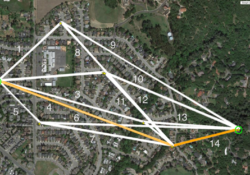What is the Data-Centric approach?
Problem: Complex and Ineffective Security Solutions
It's common to think of connections as point-to-point, but in reality, they rarely are.
Data moves across multiple VPNs, servers, and firewalls on its journey from source to destination. Most security tools, however, were designed for securing point-to-point infrastructure and network perimeters.
As a result, security solutions are often stiched together at various handoff points, requiring intricate coordination of data decryption, re-encryption, ongoing configurations, and key management in an attempt to prevent breaches.
Solution: Operant’s Named Data Networking (NDN)
Operant is built on Named Data Networking (NDN), a paradigm shift that addresses the key challenges in modern network communications, including resiliency, security, and observability. NDN enables secure communications, ensuring data is always protected, regardless the underlying channels.
NDN focuses on individual data packets. Each packet is named, secured, and immutable, allowing it to be delivered across any link capable of transmitting data. This ensures data confidentiality, integrity, and availability (CIA). Additionally, NDN enables each authenticated entity to define trust policies, determining the authority of certificates.
The data-centric approach offers the ability to encrypt, authenticate, and validate data. This fundamental technology offers seamless end-to-end security for all data flows, regardless of network topology or number of handoffs.
Allows for multi-path communications enabling seamless machine-to-machine connections
Can connect over ‘any link that can pass bit’, making it easy to deploy, even in across complex systems
Sharing data only visible to trusted parties. Assisting with data flows across both internal and external parties
Each data packet is signed, encrypted, and authenticated. Allowing for each transaction to be authenticated
Game Changing Cyber-Security

In 2021, the US Department of Energy published a report calling Operant's technology “game changing” in the category of cybersecurity solutions required to transition the US electric grid to a distributed network of interconnected machines, while also protecting national security.
Identity
Every machine, AI agent, workload, and edge device is assigned a unique, verifiable identity
Access
Once authenticated, Trust policies are enforced to define who can access what, when, and how
Administration
An intuitive abstraction layer that simplifies complexity, while seamlessly integrating with existing systems and team workflows
Updates and Insights from the Operant Team
Want to know more?
Get in touch and we'll get back to you as soon as we can. We look forward to hearing from you!



